Page 37 of 532
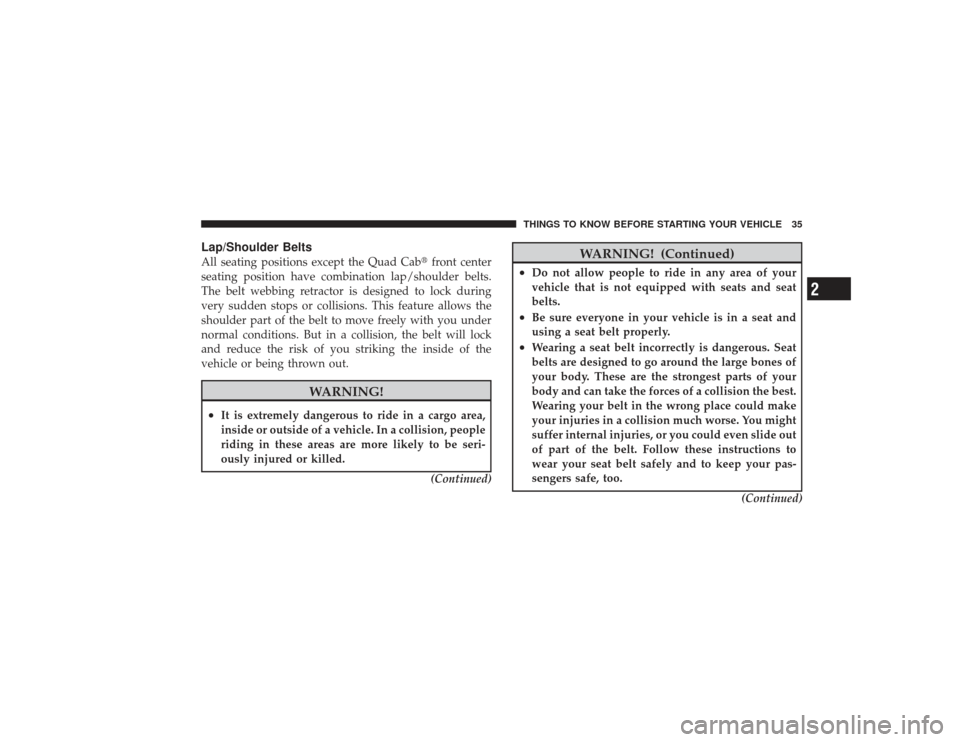
Lap/Shoulder BeltsAll seating positions except the Quad Cab�front center
seating position have combination lap/shoulder belts.
The belt webbing retractor is designed to lock during
very sudden stops or collisions. This feature allows the
shoulder part of the belt to move freely with you under
normal conditions. But in a collision, the belt will lock
and reduce the risk of you striking the inside of the
vehicle or being thrown out.
WARNING!
•
It is extremely dangerous to ride in a cargo area,
inside or outside of a vehicle. In a collision, people
riding in these areas are more likely to be seri-
ously injured or killed.
(Continued)
WARNING! (Continued)
•
Do not allow people to ride in any area of your
vehicle that is not equipped with seats and seat
belts.
•
Be sure everyone in your vehicle is in a seat and
using a seat belt properly.
•
Wearing a seat belt incorrectly is dangerous. Seat
belts are designed to go around the large bones of
your body. These are the strongest parts of your
body and can take the forces of a collision the best.
Wearing your belt in the wrong place could make
your injuries in a collision much worse. You might
suffer internal injuries, or you could even slide out
of part of the belt. Follow these instructions to
wear your seat belt safely and to keep your pas-
sengers safe, too.(Continued)THINGS TO KNOW BEFORE STARTING YOUR VEHICLE 35
2
Page 42 of 532
Regular Cab Front Center Three-Point Belt1. The front center seat belt on the Regular Cab may be
disconnected to open up utilization of the storage areas
behind the front seats. The black latch plate can be
detached from the black keyed seat belt buckle located on
the inboard side of the passenger seat. Insert the vehicle
ignition key into the center white slot on the black buckle.
The black buckle latch plate can be removed when the
key is pressed into the buckle. Allow the retractor to take
up the surplus webbing, and the buckles will hang
vertically from the cab back exit bezel, thus freeing up all
the area behind the front seats.2. To reattach the seat belt to the front center seat, pull
the black buckle latch plate forward from the cab back
panel and insert it into the black keyed buckle until there
is an audible click. Refer to the previous section for the
proper seat belt usage.
Detaching Buckle with Key
40 THINGS TO KNOW BEFORE STARTING YOUR VEHICLE
Page 44 of 532
WARNING!
If the black latch and buckle are not connected when
the seat belt is used by an occupant, the seat belt will
not restrain you properly.
Adjustable Upper Shoulder Belt AnchorageIn the front row outboard seats, the shoulder belt can be
adjusted upward or downward to help position the belt
away from your neck. Press the button located on the
upper belt guide, and then move it up or down to the
position that fits you best.
In-Use Position
Shoulder Belt Adjustment
42 THINGS TO KNOW BEFORE STARTING YOUR VEHICLE
Page 51 of 532
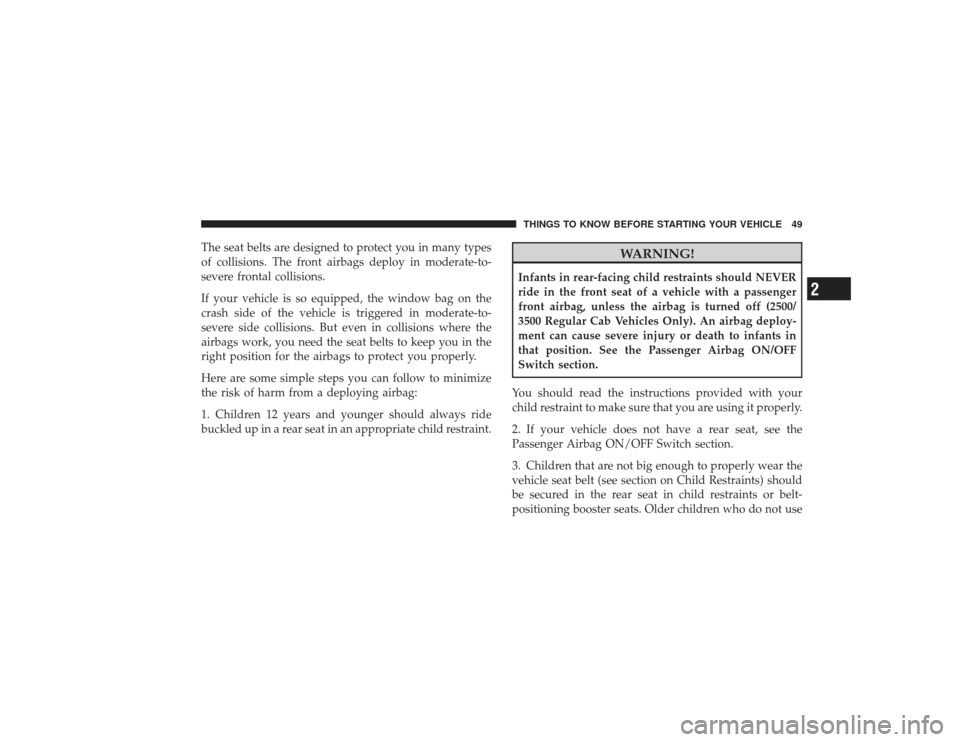
The seat belts are designed to protect you in many types
of collisions. The front airbags deploy in moderate-to-
severe frontal collisions.
If your vehicle is so equipped, the window bag on the
crash side of the vehicle is triggered in moderate-to-
severe side collisions. But even in collisions where the
airbags work, you need the seat belts to keep you in the
right position for the airbags to protect you properly.
Here are some simple steps you can follow to minimize
the risk of harm from a deploying airbag:
1. Children 12 years and younger should always ride
buckled up in a rear seat in an appropriate child restraint.
WARNING!
Infants in rear-facing child restraints should NEVER
ride in the front seat of a vehicle with a passenger
front airbag, unless the airbag is turned off (2500/
3500 Regular Cab Vehicles Only). An airbag deploy-
ment can cause severe injury or death to infants in
that position. See the Passenger Airbag ON/OFF
Switch section.
You should read the instructions provided with your
child restraint to make sure that you are using it properly.
2. If your vehicle does not have a rear seat, see the
Passenger Airbag ON/OFF Switch section.
3. Children that are not big enough to properly wear the
vehicle seat belt (see section on Child Restraints) should
be secured in the rear seat in child restraints or belt-
positioning booster seats. Older children who do not useTHINGS TO KNOW BEFORE STARTING YOUR VEHICLE 49
2
Page 52 of 532
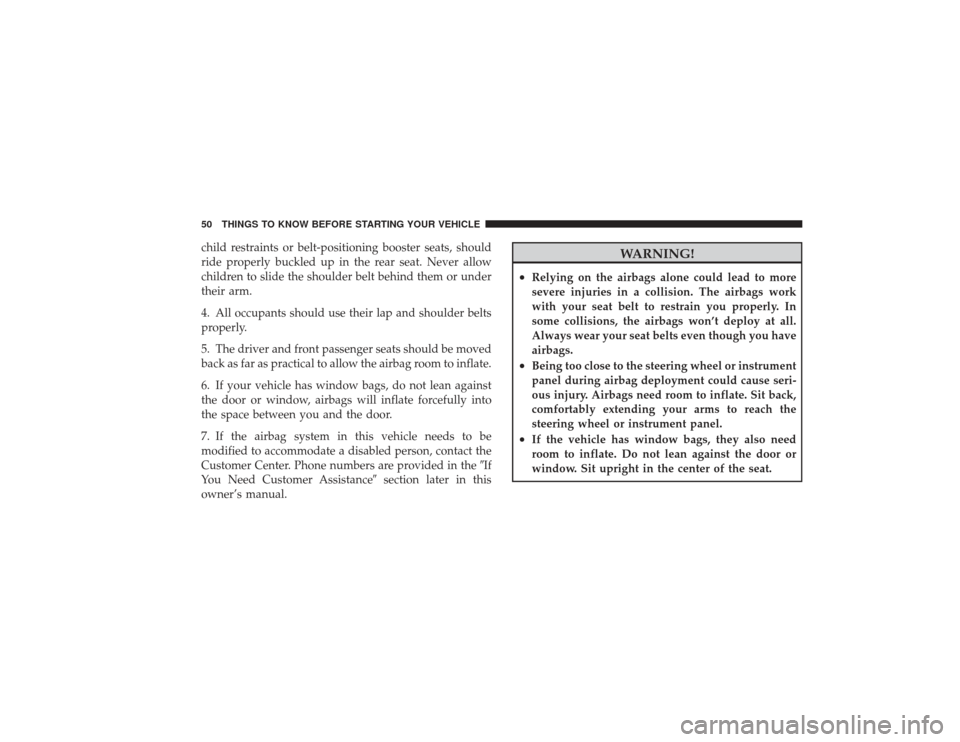
child restraints or belt-positioning booster seats, should
ride properly buckled up in the rear seat. Never allow
children to slide the shoulder belt behind them or under
their arm.
4. All occupants should use their lap and shoulder belts
properly.
5. The driver and front passenger seats should be moved
back as far as practical to allow the airbag room to inflate.
6. If your vehicle has window bags, do not lean against
the door or window, airbags will inflate forcefully into
the space between you and the door.
7. If the airbag system in this vehicle needs to be
modified to accommodate a disabled person, contact the
Customer Center. Phone numbers are provided in the�If
You Need Customer Assistance� section later in this
owner’s manual.
WARNING!
•
Relying on the airbags alone could lead to more
severe injuries in a collision. The airbags work
with your seat belt to restrain you properly. In
some collisions, the airbags won’t deploy at all.
Always wear your seat belts even though you have
airbags.
•
Being too close to the steering wheel or instrument
panel during airbag deployment could cause seri-
ous injury. Airbags need room to inflate. Sit back,
comfortably extending your arms to reach the
steering wheel or instrument panel.
•
If the vehicle has window bags, they also need
room to inflate. Do not lean against the door or
window. Sit upright in the center of the seat.
50 THINGS TO KNOW BEFORE STARTING YOUR VEHICLE
Page 63 of 532
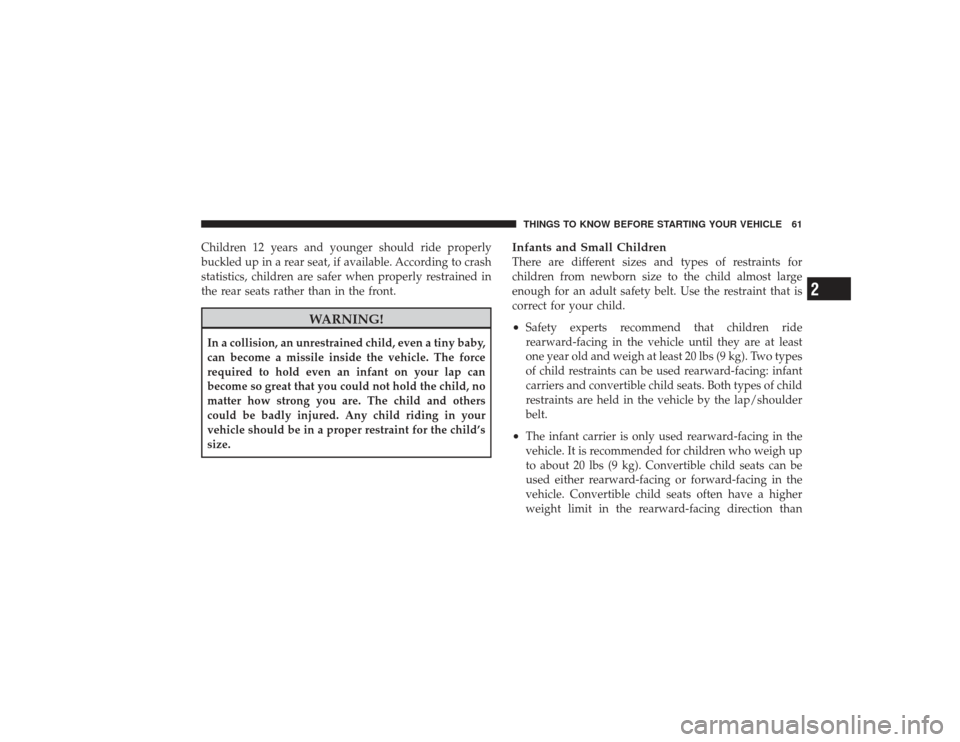
Children 12 years and younger should ride properly
buckled up in a rear seat, if available. According to crash
statistics, children are safer when properly restrained in
the rear seats rather than in the front.
WARNING!
In a collision, an unrestrained child, even a tiny baby,
can become a missile inside the vehicle. The force
required to hold even an infant on your lap can
become so great that you could not hold the child, no
matter how strong you are. The child and others
could be badly injured. Any child riding in your
vehicle should be in a proper restraint for the child’s
size.
Infants and Small ChildrenThere are different sizes and types of restraints for
children from newborn size to the child almost large
enough for an adult safety belt. Use the restraint that is
correct for your child.•
Safety experts recommend that children ride
rearward-facing in the vehicle until they are at least
one year old and weigh at least 20 lbs (9 kg). Two types
of child restraints can be used rearward-facing: infant
carriers and convertible child seats. Both types of child
restraints are held in the vehicle by the lap/shoulder
belt.
•
The infant carrier is only used rearward-facing in the
vehicle. It is recommended for children who weigh up
to about 20 lbs (9 kg). Convertible child seats can be
used either rearward-facing or forward-facing in the
vehicle. Convertible child seats often have a higher
weight limit in the rearward-facing direction thanTHINGS TO KNOW BEFORE STARTING YOUR VEHICLE 61
2
Page 64 of 532
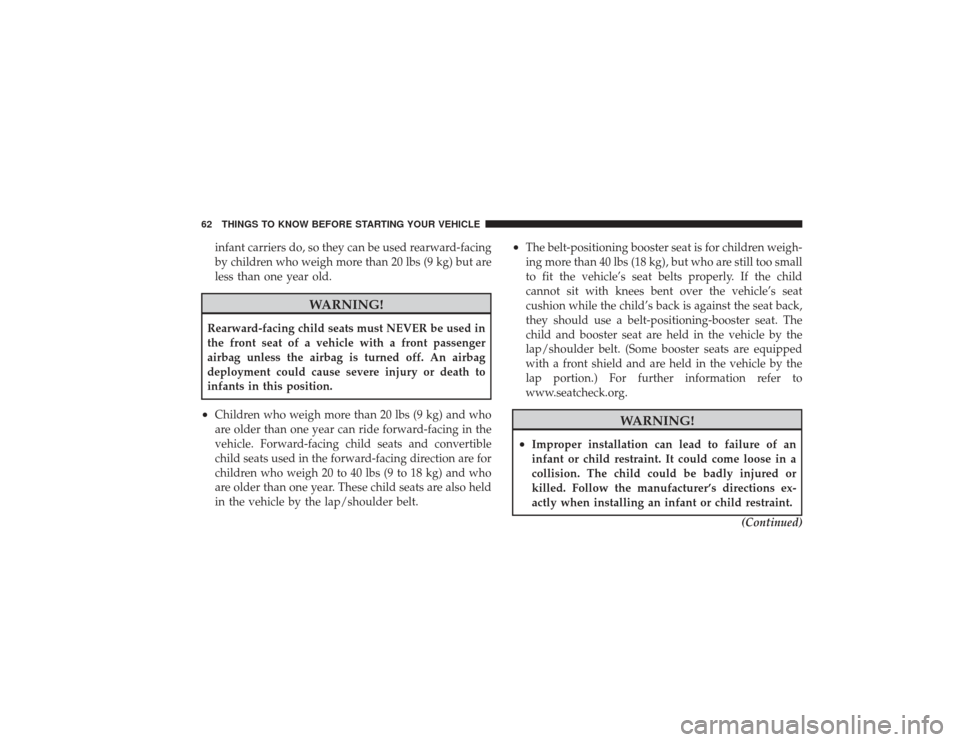
infant carriers do, so they can be used rearward-facing
by children who weigh more than 20 lbs (9 kg) but are
less than one year old.
WARNING!
Rearward-facing child seats must NEVER be used in
the front seat of a vehicle with a front passenger
airbag unless the airbag is turned off. An airbag
deployment could cause severe injury or death to
infants in this position.•
Children who weigh more than 20 lbs (9 kg) and who
are older than one year can ride forward-facing in the
vehicle. Forward-facing child seats and convertible
child seats used in the forward-facing direction are for
children who weigh 20 to 40 lbs (9 to 18 kg) and who
are older than one year. These child seats are also held
in the vehicle by the lap/shoulder belt.
•
The belt-positioning booster seat is for children weigh-
ing more than 40 lbs (18 kg), but who are still too small
to fit the vehicle’s seat belts properly. If the child
cannot sit with knees bent over the vehicle’s seat
cushion while the child’s back is against the seat back,
they should use a belt-positioning-booster seat. The
child and booster seat are held in the vehicle by the
lap/shoulder belt. (Some booster seats are equipped
with a front shield and are held in the vehicle by the
lap portion.) For further information refer to
www.seatcheck.org.
WARNING!
•
Improper installation can lead to failure of an
infant or child restraint. It could come loose in a
collision. The child could be badly injured or
killed. Follow the manufacturer’s directions ex-
actly when installing an infant or child restraint.(Continued)
62 THINGS TO KNOW BEFORE STARTING YOUR VEHICLE
Page 67 of 532
Identification dots are located above the standard cab
front seat lower anchorages as a guide for locating lower
anchors.
NOTE:For children riding in the front seat of a Regular
Cab model, refer to the “Passenger Airbag ON/OFF
Switch” located in this section.
Regular Cab Passenger Seat
Quad Cab� Rear Outboard Seats
THINGS TO KNOW BEFORE STARTING YOUR VEHICLE 65
2